

How to Write a Concept Note: A Step-by-Step Guide
Feeling behind on ai.
You're not alone. The Neuron is a daily AI newsletter that tracks the latest AI trends and tools you need to know. Join 400,000+ professionals from top companies like Microsoft, Apple, Salesforce and more. 100% FREE.
Concept notes are important documents that serve as a brief outline of a project. They are used to present a proposed project to potential stakeholders and funders, and are usually requested before a full project proposal is submitted. If you are planning to embark on a new project, it is essential to know how to write a concept note. In this guide, we'll take you through the step-by-step process of writing a winning concept note.
Understanding the Purpose of a Concept Note
Before we delve into the details of how to write a concept note, it is important to understand its purpose. A concept note serves several functions:
What is a Concept Note?
A concept note is a brief outline of a project proposal, usually submitted to potential stakeholders and funders to solicit their support.
Let’s take an example of a non-profit organization that wants to start a new project to provide education to underprivileged children. The organization will need funding and support from donors to make this project a success. To attract potential donors, the organization will need to submit a concept note that outlines the basic details of the project.
Why is a Concept Note Important?
Concept notes are important because they help to identify potential stakeholders and funders for a proposed project. By providing a brief overview of the project, concept notes help to gauge interest and support. This is especially important when dealing with multiple potential stakeholders and funders, as it allows the organization to tailor their proposal to the interests of each party.
Moreover, concept notes help organizations to save time and resources. Instead of preparing a full proposal for every potential stakeholder or funder, concept notes can be used to filter out those who are not interested in the project, allowing the organization to focus on those who are.
When to Use a Concept Note?
Concept notes are usually requested by potential stakeholders and funders before a full project proposal is submitted. They can also be used to introduce a new project to an organization or community. In addition, concept notes can be used as a tool for internal planning and decision-making.
For example, a company may use a concept note to introduce a new product or service to its employees before launching it to the public. This allows the company to gather feedback and make any necessary changes before investing resources into a full launch.
In conclusion, concept notes are an important tool for organizations to attract support and funding for their projects. By providing a brief overview of the project, concept notes help to gauge interest and support, saving time and resources. They can be used to introduce new projects to stakeholders and funders, as well as for internal planning and decision-making.
Key Components of a Concept Note
The following are key components that should be included when writing a concept note:
Project Title
The project title should be clear and concise. It should capture the essence of the project in a few words.
Project Objective
The project objective should be clearly stated, and should contain a succinct statement of what the project intends to achieve.
Background and Context
The background and context should provide an overview of the problem that the project intends to address. It should also highlight the relevance of the problem to the target audience and the broader community.
Target Audience and Beneficiaries
The target audience and beneficiaries should be clearly identified. This helps to ensure that the project is designed to meet the needs of the intended beneficiaries.
Project Activities and Methodology
The project activities and methodology should describe the specific steps that will be taken to achieve the project objectives. It should also provide details on how the project will be implemented.
Expected Outcomes and Impact
The expected outcomes and impact should clearly state what the project hopes to achieve and how it will contribute to the broader goals of the organization or community.
Monitoring and Evaluation
The monitoring and evaluation plan should outline how the project will be monitored and evaluated to determine its success.
Budget and Resources
The budget and resources section should provide a detailed breakdown of the costs associated with the project, as well as the resources required to implement it.
Step-by-Step Guide to Writing a Concept Note
Now that we have covered the key components of a concept note, it is time to take you through a step-by-step guide to writing a winning concept note.
Step 1: Research and Preparation
Before you start writing your concept note, it is important to conduct thorough research on the problem you are seeking to address, the target audience, and the available resources. This will help you to develop a comprehensive understanding of the project and its requirements.
Step 2: Develop a Clear Project Objective
The project objective is the backbone of your concept note. It should be clear, concise, and specific. A well-defined objective will help you to stay focused on the project and ensure that the project is designed to achieve the intended outcomes.
Step 3: Provide a Strong Background and Context
The background and context section of your concept note should provide a clear understanding of the problem the project intends to address and its relevance to the target audience and the broader community. This section should demonstrate the importance of the project and why it is needed.
Step 4: Identify Your Target Audience and Beneficiaries
The target audience and beneficiaries section of your concept note should clearly identify who the project is meant to benefit. This section should also provide details on how the project will improve the lives of the intended beneficiaries.
Step 5: Outline Your Project Activities and Methodology
The project activities and methodology section of your concept note should provide a detailed explanation of how the project will achieve its objectives. This section should outline the specific steps that will be taken to implement the project and achieve the desired outcomes.
Step 6: Describe Expected Outcomes and Impact
The expected outcomes and impact section of your concept note should detail the expected results of the project and how they will contribute to the broader goals of the organization or community. This section should also provide a clear understanding of the impact the project is expected to have on the beneficiaries.
Step 7: Develop a Monitoring and Evaluation Plan
The monitoring and evaluation plan should outline how the project will be monitored and evaluated to determine its success. This section should also include the indicators that will be used to measure the project's impact.
Step 8: Prepare a Budget and Identify Resources
The budget and resources section of your concept note should provide a detailed breakdown of the costs associated with the project, as well as the resources required to implement it. This section should also include details on how the project will be funded.
By following these steps, you will be able to develop a comprehensive and winning concept note that will help you to secure funding for your project. Remember to keep your concept note clear, concise and focused on the project objectives. Good luck!
ChatGPT Prompt for Writing a Concept Note
Use the following prompt in an AI chatbot . Below each prompt, be sure to provide additional details about your situation. These could be scratch notes, what you'd like to say or anything else that guides the AI model to write a certain way.
Please prepare a comprehensive and detailed document outlining the key ideas, objectives, and strategies for a proposed project or initiative. This document should clearly articulate the purpose of the project, the target audience, the expected outcomes, and the resources required to implement it. The concept note should be well-structured, concise, and informative, providing a clear roadmap for the proposed project and demonstrating its potential impact and value.
[ADD ADDITIONAL CONTEXT. CAN USE BULLET POINTS.]
You Might Also Like...
How to write a thoughtful condolence note, how to write a comprehensive dap note.

Concept Papers in Research: Deciphering the blueprint of brilliance
Concept papers hold significant importance as a precursor to a full-fledged research proposal in academia and research. Understanding the nuances and significance of a concept paper is essential for any researcher aiming to lay a strong foundation for their investigation.
Table of Contents
What Is Concept Paper
A concept paper can be defined as a concise document which outlines the fundamental aspects of a grant proposal. It outlines the initial ideas, objectives, and theoretical framework of a proposed research project. It is usually two to three-page long overview of the proposal. However, they differ from both research proposal and original research paper in lacking a detailed plan and methodology for a specific study as in research proposal provides and exclusion of the findings and analysis of a completed research project as in an original research paper. A concept paper primarily focuses on introducing the basic idea, intended research question, and the framework that will guide the research.
Purpose of a Concept Paper
A concept paper serves as an initial document, commonly required by private organizations before a formal proposal submission. It offers a preliminary overview of a project or research’s purpose, method, and implementation. It acts as a roadmap, providing clarity and coherence in research direction. Additionally, it also acts as a tool for receiving informal input. The paper is used for internal decision-making, seeking approval from the board, and securing commitment from partners. It promotes cohesive communication and serves as a professional and respectful tool in collaboration.
These papers aid in focusing on the core objectives, theoretical underpinnings, and potential methodology of the research, enabling researchers to gain initial feedback and refine their ideas before delving into detailed research.
Key Elements of a Concept Paper
Key elements of a concept paper include the title page , background , literature review , problem statement , methodology, timeline, and references. It’s crucial for researchers seeking grants as it helps evaluators assess the relevance and feasibility of the proposed research.
Writing an effective concept paper in academic research involves understanding and incorporating essential elements:
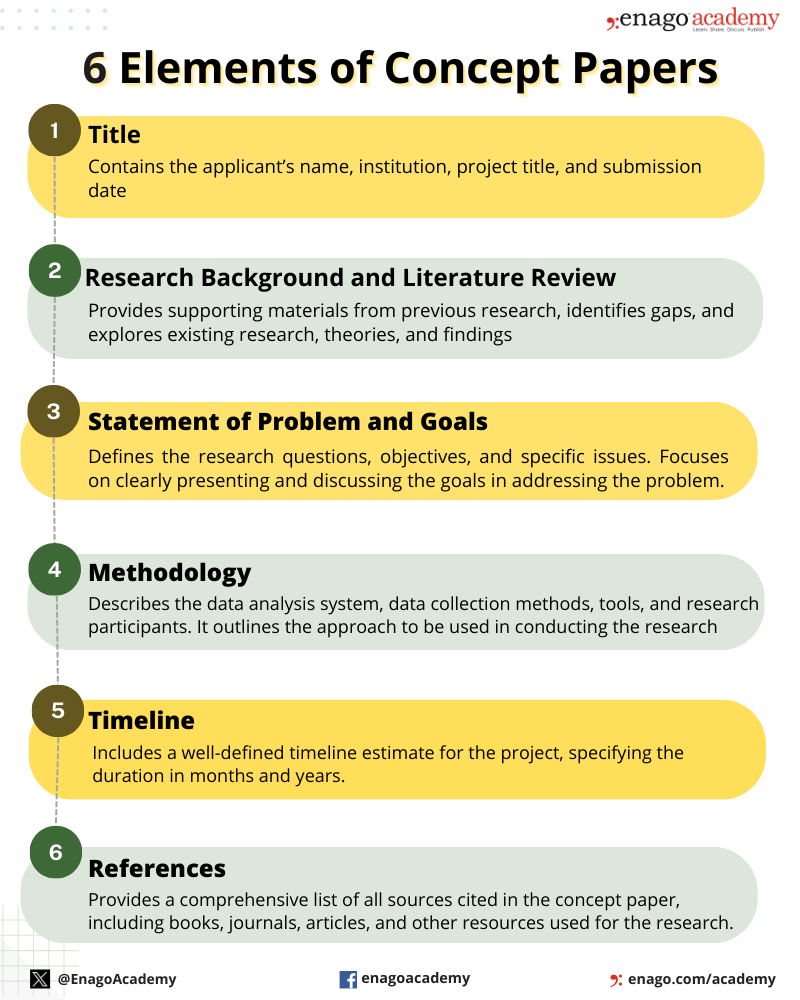
How to Write a Concept Paper?
To ensure an effective concept paper, it’s recommended to select a compelling research topic, pose numerous research questions and incorporate data and numbers to support the project’s rationale. The document must be concise (around five pages) after tailoring the content and following the formatting requirements. Additionally, infographics and scientific illustrations can enhance the document’s impact and engagement with the audience. The steps to write a concept paper are as follows:
1. Write a Crisp Title:
Choose a clear, descriptive title that encapsulates the main idea. The title should express the paper’s content. It should serve as a preview for the reader.
2. Provide a Background Information:
Give a background information about the issue or topic. Define the key terminologies or concepts. Review existing literature to identify the gaps your concept paper aims to fill.
3. Outline Contents in the Introduction:
Introduce the concept paper with a brief overview of the problem or idea you’re addressing. Explain its significance. Identify the specific knowledge gaps your research aims to address and mention any contradictory theories related to your research question.
4. Define a Mission Statement:
The mission statement follows a clear problem statement that defines the problem or concept that need to be addressed. Write a concise mission statement that engages your research purpose and explains why gaining the reader’s approval will benefit your field.
5. Explain the Research Aim and Objectives:
Explain why your research is important and the specific questions you aim to answer through your research. State the specific goals and objectives your concept intends to achieve. Provide a detailed explanation of your concept. What is it, how does it work, and what makes it unique?
6. Detail the Methodology:
Discuss the research methods you plan to use, such as surveys, experiments, case studies, interviews, and observations. Mention any ethical concerns related to your research.
7. Outline Proposed Methods and Potential Impact:
Provide detailed information on how you will conduct your research, including any specialized equipment or collaborations. Discuss the expected results or impacts of implementing the concept. Highlight the potential benefits, whether social, economic, or otherwise.
8. Mention the Feasibility
Discuss the resources necessary for the concept’s execution. Mention the expected duration of the research and specific milestones. Outline a proposed timeline for implementing the concept.
9. Include a Support Section:
Include a section that breaks down the project’s budget, explaining the overall cost and individual expenses to demonstrate how the allocated funds will be used.
10. Provide a Conclusion:
Summarize the key points and restate the importance of the concept. If necessary, include a call to action or next steps.
Although the structure and elements of a concept paper may vary depending on the specific requirements, you can tailor your document based on the guidelines or instructions you’ve been given.
Here are some tips to write a concept paper:
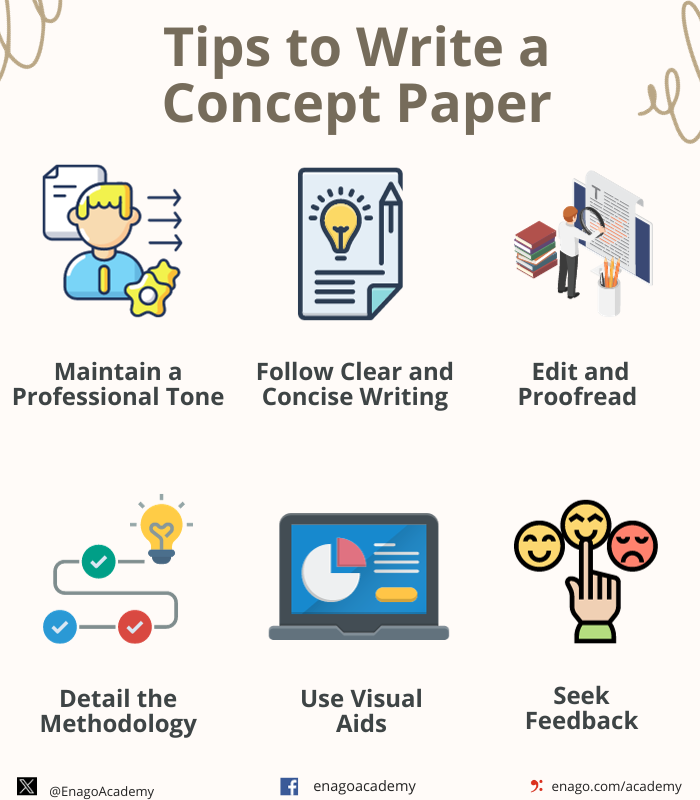
Example of a Concept Paper
Here is an example of a concept paper. Please note, this is a generalized example. Your concept paper should align with the specific requirements, guidelines, and objectives you aim to achieve in your proposal. Tailor it accordingly to the needs and context of the initiative you are proposing.
Download Now!
Importance of a Concept Paper
Concept papers serve various fields, influencing the direction and potential of research in science, social sciences, technology, and more. They contribute to the formulation of groundbreaking studies and novel ideas that can impact societal, economic, and academic spheres.
A concept paper serves several crucial purposes in various fields:
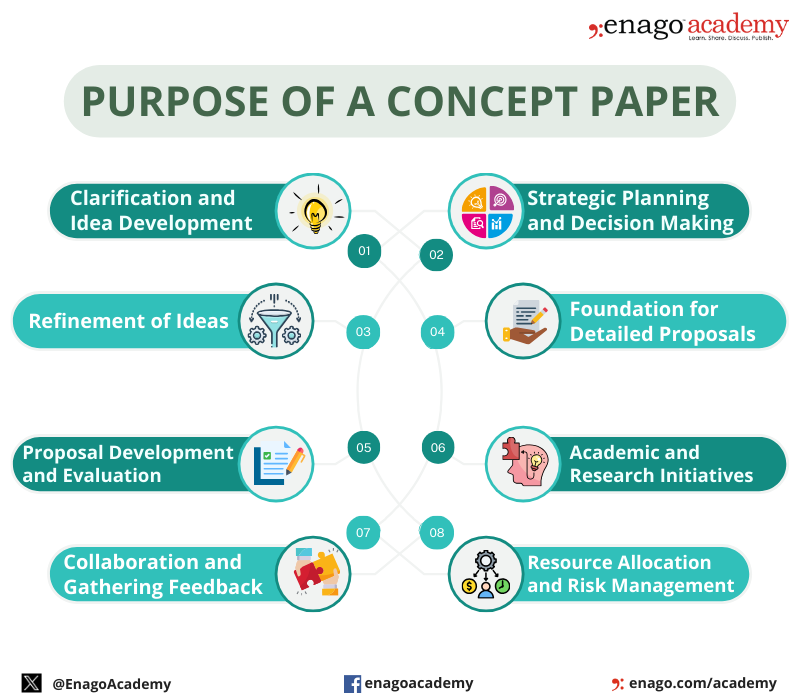
In summary, a well-crafted concept paper is essential in outlining a clear, concise, and structured framework for new ideas or proposals. It helps in assessing the feasibility, viability, and potential impact of the concept before investing significant resources into its implementation.
How well do you understand concept papers? Test your understanding now!
Fill the Details to Check Your Score

Role of AI in Writing Concept Papers
The increasing use of AI, particularly generative models, has facilitated the writing process for concept papers. Responsible use involves leveraging AI to assist in ideation, organization, and language refinement while ensuring that the originality and ethical standards of research are maintained.
AI plays a significant role in aiding the creation and development of concept papers in several ways:
1. Idea Generation and Organization
AI tools can assist in brainstorming initial ideas for concept papers based on key concepts. They can help in organizing information, creating outlines, and structuring the content effectively.
2. Summarizing Research and Data Analysis
AI-powered tools can assist in conducting comprehensive literature reviews, helping writers to gather and synthesize relevant information. AI algorithms can process and analyze vast amounts of data, providing insights and statistics to support the concept presented in the paper.
3. Language and Style Enhancement
AI grammar checker tools can help writers by offering grammar, style, and tone suggestions, ensuring professionalism. It can also facilitate translation, in case a global collaboration.
4. Collaboration and Feedback
AI platforms offer collaborative features that enable multiple authors to work simultaneously on a concept paper, allowing for real-time contributions and edits.
5. Customization and Personalization
AI algorithms can provide personalized recommendations based on the specific requirements or context of the concept paper. They can assist in tailoring the concept paper according to the target audience or specific guidelines.
6. Automation and Efficiency
AI can automate certain tasks, such as citation formatting, bibliography creation, or reference checking, saving time for the writer.
7. Analytics and Prediction
AI models can predict potential outcomes or impacts based on the information provided, helping writers anticipate the possible consequences of the proposed concept.
8. Real-Time Assistance
AI-driven chat-bots can provide real-time support and answers to specific questions related to the concept paper writing process.
AI’s role in writing concept papers significantly streamlines the writing process, enhances the quality of the content, and provides valuable assistance in various stages of development, contributing to the overall effectiveness of the final document.
Concept papers serve as the stepping stone in the research journey, aiding in the crystallization of ideas and the formulation of robust research proposals. It the cornerstone for translating ideas into impactful realities. Their significance spans diverse domains, from academia to business, enabling stakeholders to evaluate, invest, and realize the potential of groundbreaking concepts.
Frequently Asked Questions
A concept paper can be defined as a concise document outlining the fundamental aspects of a grant proposal such as the initial ideas, objectives, and theoretical framework of a proposed research project.
A good concept paper should offer a clear and comprehensive overview of the proposed research. It should demonstrate a strong understanding of the subject matter and outline a structured plan for its execution.
Concept paper is important to develop and clarify ideas, develop and evaluate proposal, inviting collaboration and collecting feedback, presenting proposals for academic and research initiatives and allocating resources.
I got wonderful idea
It helps a lot for my concept paper.
Rate this article Cancel Reply
Your email address will not be published.

Enago Academy's Most Popular Articles

- AI in Academia
AI vs AI: How to detect image manipulation and avoid academic misconduct
The scientific community is facing a new frontier of controversy as artificial intelligence (AI) is…

- Diversity and Inclusion
Need for Diversifying Academic Curricula: Embracing missing voices and marginalized perspectives
In classrooms worldwide, a single narrative often dominates, leaving many students feeling lost. These stories,…

- Career Corner
- Trending Now
Recognizing the signs: A guide to overcoming academic burnout
As the sun set over the campus, casting long shadows through the library windows, Alex…

Reassessing the Lab Environment to Create an Equitable and Inclusive Space
The pursuit of scientific discovery has long been fueled by diverse minds and perspectives. Yet…

Simplifying the Literature Review Journey — A comparative analysis of 6 AI summarization tools
Imagine having to skim through and read mountains of research papers and books, only to…

Sign-up to read more
Subscribe for free to get unrestricted access to all our resources on research writing and academic publishing including:
- 2000+ blog articles
- 50+ Webinars
- 10+ Expert podcasts
- 50+ Infographics
- 10+ Checklists
- Research Guides
We hate spam too. We promise to protect your privacy and never spam you.
I am looking for Editing/ Proofreading services for my manuscript Tentative date of next journal submission:

As a researcher, what do you consider most when choosing an image manipulation detector?

Community Blog
Keep up-to-date on postgraduate related issues with our quick reads written by students, postdocs, professors and industry leaders.
What is a Concept Paper and How do You Write One?
- By DiscoverPhDs
- August 26, 2020

What is a Concept Paper?
A concept paper is a short document written by a researcher before starting their research project, with the purpose of explaining what the study is about, why it is important and the methods that will be used.
The concept paper will include your proposed research title, a brief introduction to the subject, the aim of the study, the research questions you intend to answer, the type of data you will collect and how you will collect it. A concept paper can also be referred to as a research proposal.
What is the Purpose of a Concept Paper?
The primary aim of a research concept paper is to convince the reader that the proposed research project is worth doing. This means that the reader should first agree that the research study is novel and interesting. They should be convinced that there is a need for this research and that the research aims and questions are appropriate.
Finally, they should be satisfied that the methods for data collection proposed are feasible, are likely to work and can be performed within the specific time period allocated for this project.
The three main scenarios in which you may need to write a concept paper are if you are:
- A final year undergraduate or master’s student preparing to start a research project with a supervisor.
- A student submitting a research proposal to pursue a PhD project under the supervision of a professor.
- A principal investigator submitting a proposal to a funding body to secure financial support for a research project.
How Long is a Concept Paper?
The concept paper format is usually between 2 and 3 pages in length for students writing proposals for undergraduate, master’s or PhD projects. Concept papers written as part of funding applications may be over 20 pages in length.
How do you Write a Concept Paper?
There are 6 important aspects to consider when writing a concept paper or research proposal:
- 1. The wording of the title page, which is best presented as a question for this type of document. At this study concept stage, you can write the title a bit catchier, for example “Are 3D Printed Engine Parts Safe for Use in Aircraft?”.
- A brief introduction and review of relevant existing literature published within the subject area and identification of where the gaps in knowledge are. This last bit is particularly important as it guides you in defining the statement of the problem. The concept paper should provide a succinct summary of ‘the problem’, which is usually related to what is unknown or poorly understood about your research topic . By the end of the concept paper, the reader should be clear on how your research idea will provide a ‘solution’ to this problem.
- The overarching research aim of your proposed study and the objectives and/or questions you will address to achieve this aim. Align all of these with the problem statement; i.e. write each research question as a clear response to addressing the limitations and gaps identified from previous literature. Also give a clear description of your primary hypothesis.
- The specific data outputs that you plan to capture. For example, will this be qualitative or quantitative data? Do you plan to capture data at specific time points or at other defined intervals? Do you need to repeat data capture to asses any repeatability and reproducibility questions?
- The research methodology you will use to capture this data, including any specific measurement or analysis equipment and software you will use, and a consideration of statistical tests to help interpret the data. If your research requires the use of questionnaires, how will these be prepared and validated? In what sort of time frame would you plan to collect this data?
- Finally, include a statement of the significance of the study , explaining why your research is important and impactful. This can be in the form of a concluding paragraph that reiterate the statement of the problem, clarifies how your research will address this and explains who will benefit from your research and how.
You may need to include a short summary of the timeline for completing the research project. Defining milestones of the time points at which you intend to complete certain tasks can help to show that you’ve considered the practicalities of running this study. It also shows that what you have proposed is feasible in order to achieve your research goal.
If you’re pitching your proposed project to a funder, they may allocate a proportion of the money based on the satisfactory outcome of each milestone. These stakeholders may also be motivated by knowing that you intend to convert your dissertation into an article for journal publication; this level of dissemination is of high importance to them.
Additionally, you may be asked to provide a brief summary of the projected costs of running the study. For a PhD project this could be the bench fees associated with consumables and the cost of any travel if required.
Make sure to include references and cite all other literature and previous research that you discuss in your concept paper.
This guide gave you an overview of the key elements you need to know about when writing concept papers. The purpose of these are first to convey to the reader what your project’s purpose is and why your research topic is important; this is based on the development of a problem statement using evidence from your literature review.
Explain how it may positively impact your research field and if your proposed research design is appropriate and your planned research method achievable.

Scientific misconduct can be described as a deviation from the accepted standards of scientific research, study and publication ethics.

A well written figure legend will explain exactly what a figure means without having to refer to the main text. Our guide explains how to write one.

In Finland, all new PhD holders are given a traditional Doctoral Hat and Doctoral Sword during a Conferment Ceremony, symbolising the freedom of research.
Join thousands of other students and stay up to date with the latest PhD programmes, funding opportunities and advice.

Browse PhDs Now

In the UK, a dissertation, usually around 20,000 words is written by undergraduate and Master’s students, whilst a thesis, around 80,000 words, is written as part of a PhD.

The title page of your dissertation or thesis conveys all the essential details about your project. This guide helps you format it in the correct way.

Dr Karki gained his PhD in the field of Nuclear and Particle Physics from Ohio University in March 2020. He is currently working as a postdoctoral associate in Prof. Haiyan Gao’s research group in Duke University.

Bijou is a second year MD-PhD candidate, starting her second year of medical school. At the end of this academic year she’ll transition into doing a genetics PhD full time at Case Western Reserve University.
Join Thousands of Students
We use cookies on this site to enhance your experience
By clicking any link on this page you are giving your consent for us to set cookies.
A link to reset your password has been sent to your email.
Back to login
We need additional information from you. Please complete your profile first before placing your order.
Thank you. payment completed., you will receive an email from us to confirm your registration, please click the link in the email to activate your account., there was error during payment, orcid profile found in public registry, download history, understanding and developing a concept paper.
- Charlesworth Author Services
- 15 December, 2021
A concept paper, simply put, is a one- to two-page written document describing an idea for a project . At this stage, there is no need to flesh out details, but rather just introduce the overall rationale of the project, how it’ll be carried out and the expected outcomes. There is no hard rule as to how this should be structured, but below are some tips on what to include and why to include them.
Discuss the rationale
The need for the project is an important aspect to address, and is often something a funding body might look for when considering funding a project. A concept paper might be the first thing a funding round requests to get an idea of what the project is all about. So make sure that it includes:
- Importance of the work being proposed
- What the impact (not the same as ‘ impact factor ’ – see later below) will be
- How the outcomes of your project might meet or respond to the need
- Priorities of your intended audience
Outline your methodology and procedures
Your overall methodology , i.e. how you intend to approach your work, should be outlined here to give your reader an idea of how you propose to achieve your research objectives. Mentioning the proposed methodology in advance allows them to conduct an independent evaluation into whether it is a valid approach.
Further, you should highlight some exciting, specific procedures or methods that you might be especially well-placed to perform. For example, your institute may have a specific piece of equipment, or you may have access to very high quality expertise. This will inspire confidence in the review panel that you are well-positioned to take the project on.
Describe the potential impact
Impact is a term often thrown around in research circles, usually relating to the ‘impact factor’ of a journal. Impact in this instance does not refer to that. The impact that you should be describing here is the real-world impact of your work.
Will your idea or innovation change people’s lives? Will it save the taxpayer money? How will it do those things?
Make sure you describe impacts that go beyond discovering something new to shaking up your research community.
A concept paper is a loose framework by which you are able to quickly communicate an idea for a piece of work you might want to do in the future. At the very least, it can help you put ideas to paper and look at them as a whole, allowing you to critically assess what is needed to make it a reality. In the best case scenario, a concept paper might be used to advance your grant applications or attract investment for your idea. Whatever you are using it for, it is a valuable piece of writing that can help you formalise your idea and make it a reality.
Read next (second) in series: Writing a successful Research Proposal
Maximise your publication success with Charlesworth Author Services.
Charlesworth Author Services, a trusted brand supporting the world’s leading academic publishers, institutions and authors since 1928.
To know more about our services, visit: Our Services
Share with your colleagues
Related resources.

Writing a successful Research Proposal
Charlesworth Author Services 08/03/2022 00:00:00

Concept Paper vs. Research Proposal – and when to use each

Preparing and writing your PhD Research Proposal
Charlesworth Author Services 02/08/2021 00:00:00
Related webinars

Bitesize Webinar: Writing Competitive Grant Proposals: Module 1- Unpacking the Request for Proposals
Charlesworth Author Services 09/03/2021 00:00:00

Bitesize Webinar: Writing Competitive Grant Proposals: Module 2- Choosing the Right Funder

Bitesize Webinar: Writing Competitive Grant Proposals: Module 3- Structuring the Proposal

Bitesize Webinar: Writing Competitive Grant Proposals: Module 4- Developing a Grant Budget

How to write the Rationale for your research
Charlesworth Author Services 19/11/2021 00:00:00

A guide to finding the right Funding Agency for your project
Charlesworth Author Services 27/01/2021 00:00:00

Difference between Methodology and Method
Charlesworth Author Services 15/12/2021 00:00:00
How To Write a Concept Paper for Academic Research: An Ultimate Guide
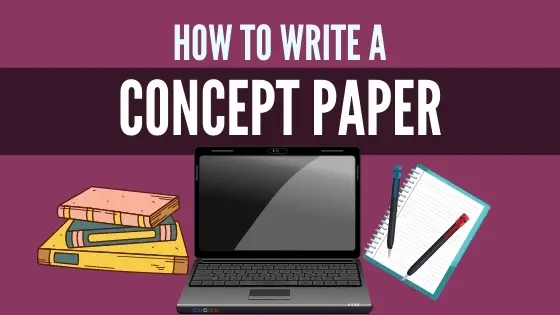
A concept paper is one of the first steps in helping you fully realize your research project. Because of this, some schools opt to teach students how to write concept papers as early as high school. In college, professors sometimes require their students to submit concept papers before suggesting their research projects to serve as the foundations for their theses.
If you’re reading this right now, you’ve probably been assigned by your teacher or professor to write a concept paper. To help you get started, we’ve prepared a comprehensive guide on how to write a proper concept paper.
Related: How to Write Significance of the Study (with Examples)

Table of Contents
What is the concept paper, 1. academic research concept papers, 2. advertising concept papers, 3. research grant concept papers, concept paper vs. research proposal, tips for finding your research topic, 2. think of research questions that you want to answer in your project, 3. formulate your research hypothesis, 4. plan out how you will achieve, analyze, and present your data, 2. introduction, 3. purpose of the study, 4. preliminary literature review, 5. objectives of the study, 6. research questions and hypotheses, 7. proposed methodology, 8. proposed research timeline, 9. references, sample concept paper for research proposal (pdf), tips for writing your concept paper.
Generally, a concept paper is a summary of everything related to your proposed project or topic. A concept paper indicates what the project is all about, why it’s important, and how and when you plan to conduct your project.
Different Types of the Concept Paper and Their Uses

This type of concept paper is the most common type and the one most people are familiar with. Concept papers for academic research are used by students to provide an outline for their prospective research topics.
These concept papers are used to help students flesh out all the information and ideas related to their topic so that they may arrive at a more specific research hypothesis.
Since this is the most common type of concept paper, it will be the main focus of this article.
Advertising concept papers are usually written by the creative and concept teams in advertising and marketing agencies.
Through a concept paper, the foundation or theme for an advertising campaign or strategy is formed. The concept paper can also serve as a bulletin board for ideas that the creative and concept teams can add to or develop.
This type of concept paper usually discusses who the target audience of the campaign is, what approach of the campaign will be, how the campaign will be implemented, and the projected benefits and impact of the campaign to the company’s sales, consumer base, and other aspects of the company.
This type of concept paper is most common in the academe and business world. Alongside proving why your research project should be conducted, a research grant concept paper must also appeal to the company or funding agency on why they should be granted funds.
The paper should indicate a proposed timeline and budget for the entire project. It should also be able to persuade the company or funding agency on the benefits of your research project– whether it be an increase in sales or productivity or for the benefit of the general public.
It’s important to discuss the differences between the two because a lot of people often use these terms interchangeably.
A concept paper is one of the first steps in conducting a research project. It is during this process that ideas and relevant information to the research topic are gathered to produce the research hypothesis. Thus, a concept paper should always precede the research proposal.
A research proposal is a more in-depth outline of a more fleshed-out research project. This is the final step before a researcher can conduct their research project. Although both have similar elements and structures, a research proposal is more specific when it comes to how the entire research project will be conducted.
Getting Started on Your Concept Paper
1. find a research topic you are interested in.
When choosing a research topic, make sure that it is something you are passionate about or want to learn more about. If you are writing one for school, make sure it is still relevant to the subject of your class. Choosing a topic you aren’t invested in may cause you to lose interest in your project later on, which may lower the quality of the research you’ll produce.
A research project may last for months and even years, so it’s important that you will never lose interest in your topic.
- Look for inspiration everywhere. Take a walk outside, read books, or go on your computer. Look around you and try to brainstorm ideas about everything you see. Try to remember any questions you might have asked yourself before like why something is the way it is or why can’t this be done instead of that .
- Think big. If you’re having trouble thinking up a specific topic to base your research project on, choosing a broad topic and then working your way down should help.
- Is it achievable? A lot of students make the mistake of choosing a topic that is hard to achieve in terms of materials, data, and/or funding available. Before you decide on a research topic, make sure you consider these aspects. Doing so will save you time, money, and effort later on.
- Be as specific as can be. Another common mistake that students make is that they sometimes choose a research topic that is too broad. This results in extra effort and wasted time while conducting their research project. For example: Instead of “The Effects of Bananas on Hungry Monkeys” , you could specify it to “The Effects of Cavendish Bananas on Potassium-deficiency in Hungry Philippine Long-tailed Macaques in Palawan, Philippines”.
Now that you have a general idea of the topic of your research project, you now need to formulate research questions based on your project. These questions will serve as the basis for what your project aims to answer. Like your research topic, make sure these are specific and answerable.
Following the earlier example, possible research questions could be:
- Do Cavendish bananas produce more visible effects on K-deficiency than other bananas?
- How susceptible are Philippine long-tailed macaques to K-deficiency?
- What are the effects of K-deficiency in Philippine long-tailed macaques?
After formulating the research questions, you should also provide your hypothesis for each question. A research hypothesis is a tentative answer to the research problem. You must provide educated answers to the questions based on your existing knowledge of the topic before you conduct your research project.
After conducting research and collecting all of the data into the final research paper, you will then have to approve or disprove these hypotheses based on the outcome of the project.
Prepare a plan on how to acquire the data you will need for your research project. Take note of the different types of analysis you will need to perform on your data to get the desired results. Determine the nature of the relationship between different variables in your research.
Also, make sure that you are able to present your data in a clear and readable manner for those who will read your concept paper. You can achieve this by using tables, charts, graphs, and other visual aids.
Related: How to Make Conceptual Framework (with Examples and Templates)
Generalized Structure of a Concept Paper
Since concept papers are just summaries of your research project, they are usually short and no longer than 5 pages. However, for big research projects, concept papers can reach up to more than 20 pages.
Your teacher or professor may give you a certain format for your concept papers. Generally, most concept papers are double-spaced and are less than 500 words in length.
Even though there are different types of concept papers, we’ve provided you with a generalized structure that contains elements that can be found in any type of concept paper.
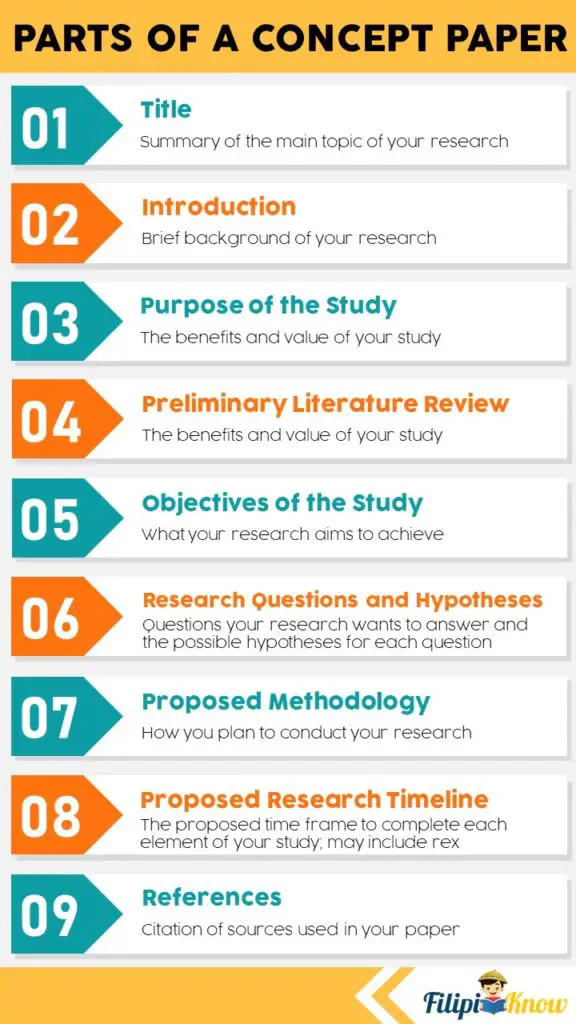
The title for your paper must be able to effectively summarize what your research is all about. Use simple words so that people who read the title of your research will know what it’s all about even without reading the entire paper.
The introduction should give the reader a brief background of the research topic and state the main objective that your project aims to achieve. This section should also include a short overview of the benefits of the research project to persuade the reader to acknowledge the need for the project.
The Purpose of the Study should be written in a way that convinces the reader of the need to address the existing problem or gap in knowledge that the research project aims to resolve. In this section, you have to go into more detail about the benefits and value of your project for the target audience/s.
This section features related studies and papers that will support your research topic. Use this section to analyze the results and methodologies of previous studies and address any gaps in knowledge or questions that your research project aims to answer. You may also use the data to assert the importance of conducting your research.
When choosing which papers and studies you should include in the Preliminary Literature Review, make sure to choose relevant and reliable sources. Reliable sources include academic journals, credible news outlets, government websites, and others. Also, take note of the authors for the papers as you will need to cite them in the References section.
Simply state the main objectives that your research is trying to achieve. The objectives should be able to indicate the direction of the study for both the reader and the researcher. As with other elements in the paper, the objectives should be specific and clearly defined.
Gather the research questions and equivalent research hypotheses you formulated in the earlier step and list them down in this section.
In this section, you should be able to guide the reader through the process of how you will conduct the research project. Make sure to state the purpose for each step of the process, as well as the type of data to be collected and the target population.
Depending on the nature of your research project, the length of the entire process can vary significantly. What’s important is that you are able to provide a reasonable and achievable timeline for your project.
Make sure the time you will allot for each component of your research won’t be too excessive or too insufficient so that the quality of your research won’t suffer.
Ensure that you will give credit to all the authors of the sources you used in your paper. Depending on your area of study or the instructions of your professor, you may need to use a certain style of citation.
There are three main citation styles: the American Psychological Association (APA), Modern Language Association (MLA), and the Chicago style.
The APA style is mostly used for papers related to education, psychology, and the sciences. The APA citation style usually follows this format:
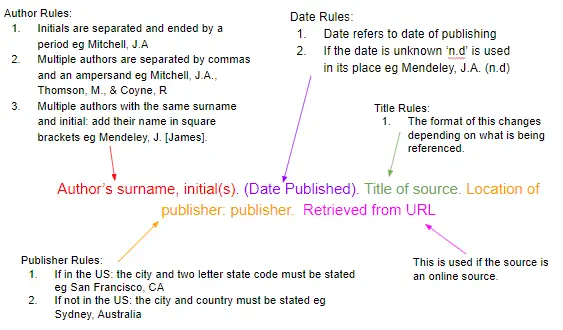
The MLA citation style is the format used by papers and manuscripts in disciplines related to the arts and humanities. The MLA citation style follows this format:
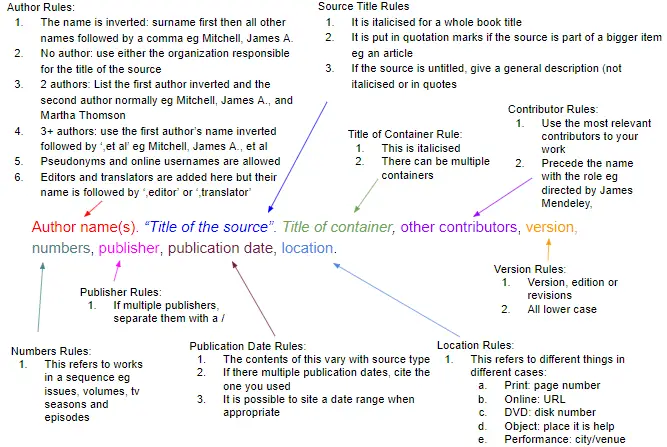
The Chicago citation style is usually used for papers related to business, history, and the fine arts. It follows this citation format:

This is a concept paper sample provided by Dr. Bernard Lango from the Jomo Kenyatta University of Agriculture and Technology (modified for use in this article). Simply click the link above the download the PDF file.
- Use simple, concise language. Minimize the use of flowery language and always try to use simple and easy-to-understand language. Too many technical or difficult words in your paper may alienate your readers and make your paper hard to read.
- Choose your sources wisely. When scouring the Internet for sources to use, you should always be wary and double-check the authenticity of your source. Doing this will increase the authenticity of your research project’s claims and ensure better data gathered during the process.
- Follow the specified format, if any. Make sure to follow any specified format when writing your concept paper. This is very important, especially if you’re writing your concept paper for class. Failure to follow the format will usually result in point deductions and delays because of multiple revisions needed.
- Proofread often. Make it a point to reread different sections of your concept paper after you write them. Another way you can do this is by taking a break for a few days and then coming back to proofread your writing. You may notice certain areas you’d like to revise or mistakes you’d like to fix. Make proofreading a habit to increase the quality of your paper.
Written by Ruth Raganit
in Career and Education , Juander How
Ruth Raganit
Ruth Raganit obtained her Bachelor of Science degree in Geology from the University of the Philippines – Diliman. Her love affair with Earth sciences began when she saw a pretty rock and wondered how it came to be. She also likes playing video games, doing digital art, and reading manga.
Browse all articles written by Ruth Raganit
Copyright Notice
All materials contained on this site are protected by the Republic of the Philippines copyright law and may not be reproduced, distributed, transmitted, displayed, published, or broadcast without the prior written permission of filipiknow.net or in the case of third party materials, the owner of that content. You may not alter or remove any trademark, copyright, or other notice from copies of the content. Be warned that we have already reported and helped terminate several websites and YouTube channels for blatantly stealing our content. If you wish to use filipiknow.net content for commercial purposes, such as for content syndication, etc., please contact us at legal(at)filipiknow(dot)net

How to Write a PhD Concept Paper

A concept paper – or concept note – is one of the initial requirements of a PhD programme. It is normally written during the PhD application process as well as early on in the programme once a student has been admitted.
A concept paper is basically a shorter version of a research proposal – in most cases between 2,000 and 2,500 words – that expresses the research ideas of the potential PhD student.
Besides being short, it should be concise yet have adequate details to convince the Department the student is applying to that he/she is worth being admitted to the programme.
Example of a title with a sub-title
References/bibliography, why do phd programmes require applicants to submit a concept paper.
A concept paper serves four main purposes:
- It gives the Department the student is applying to an idea of the student’s research interests.
- Based on point one, it informs the Department whether the student will be a good fit to the Department or not. To be a good fit, the research interests of the applicant should match those of the Department’s faculty.
- Based on the two points above, it enables the Department to offer support to the student throughout his/her PhD studies in the form of supervision and mentorship.
- Because the concept paper is written – and must be accepted – before the full proposal, it saves the student time and effort that would otherwise be spent on topics that may end up being rejected by the Department. A concept paper is therefore the first step to writing the PhD thesis/dissertation (see the figure below).
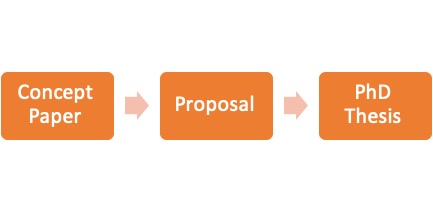
Format of a PhD Concept Paper
The format of a concept paper might vary from one university to another. A PhD student should therefore read the guidelines provided by his/her University of interest before writing a concept paper.
In general, the following is a common format of a concept paper:
Title of proposed study
The title of the proposed study is the first element of a concept paper.
The title should describe what the study is about by highlighting the variables of the study and the relationship between the variables if applicable.
The title should be short and specific: it is best to have a title that is not more than 15 words’ long.
Example of a title:
Use of Mobile Phone Applications for Weight Management in the United States
In order to add more specificity to the title, you can add a subtitle to the main title. The title and subtitle should be separated by a full colon.
Use of Mobile Phone Applications for Weight Management in the United States:
A Behavioural Economics’ Analysis
Background to the study
The background to the study contains the following elements:
- The history of the topic, both globally and in the proposed location of your study.
- What other researchers have found out from their own studies.
- What the gaps in the existing literature are, that is, what the other researchers have not addressed.
- What your study will contribute towards filling the identified gaps.
The implication of the above is that one must have conducted some literature review prior to writing the background to the study.
Statement of the problem
The statement of the problem is a clear description of the issue that the study will address, the relevance of the issue, the importance (benefits) of addressing the issue, and the method the researcher will use to address the issue.
Goal and objectives of the study
Once you have identified the problem of your study, the next step is to write the goal and objectives of the study. There is a difference between these two:
The goal of the study is a broad statement of what the researcher hopes to accomplish at the end of the study. The goal should also be related to the problem statement.
Any given project should have one goal because having many goals would lead to confusion. However, that one goal can have multiple elements in it, which would be accomplished through the project’s objectives.
The objectives of the study, on the other hand, are specific and detailed statements of how the researcher will go about accomplishing the stated goal.
The objectives should:
- Support the accomplishment of the goal.
- Follow a sequence, that is, like a step-by-step order. This will help you frame the activities needed to be undertaken in a logical manner so that the goal is achieved.
- Be stated using action verbs, for instance, “to identify”, “to create”, “to establish”, “to measure”, etc.
- Be about 3-4: having too few of objectives will limit the scope of your PhD dissertation, while having too many objectives may complicate the dissertation.
- Be SMART, that is, Specific, Measurable, Achievable, Realistic, and Time-bound.
The video below clearly explains how to set SMART goals and objectives:
https://www.youtube.com/watch?v=MAhs-m6cNzY
Important tip 1: depending on your PhD programme, you may be required to have at least 3 journal papers to qualify for graduation. Each of your objectives can be converted into a separate journal paper on its own.
Research questions and hypotheses
Every PhD dissertation needs research questions. Research questions will help the student stay focused on his/her research.
The aim of the research is to provide answers to the research questions. The answers to the questions will form the thesis statement.
Examples of research questions:
In the title example given earlier about use of mobile phone applications for weight management in the United States, a student may be interested in the following questions:
- To what extent do adults in the United States use mobile phone applications to manage their weight?
- Is there any gender disparity in the use of mobile phone apps for weight management in the United States?
- How effective are mobile apps for weight management in the United States?
Good research questions are those that can be explored deeply and widely as well as defended using evidence. Questions with ‘yes” or “no” responses are not academic-worthy.
When developing research questions, you also need to think about the data that will be required to answer the questions. Do you have access to that data? If no, will your time and financial resources allow you to collect that data?
Important tip 2: Your PhD study is time-limited therefore data requirement issues need to be thought through at the initial stages of your concept paper writing so that you don’t waste too much time either collecting the data in the future or trying to access the data if it already exists elsewhere.
Preliminary literature review
At the concept paper stage, a preliminary literature review serves three main purposes:
- It shows whether you have knowledge of the current state of debate about your chosen topic.
- It shows whether you are familiar with the experts in your chosen topic.
- It also helps you identify the research gaps.
Proposed research design, methods and procedures
This sections provides a brief overview of the research methodology that you will adopt in your study. Some issues to consider include:
- Will your study use quantitative, qualitative or mixed-methods approach?
- Will you use secondary or primary data?
- What will be the sources of your data? Will you need any ethical clearance from your university before collecting data?
- Will the data sources be readily accessible?
- Will you use external assistance for data collection? Or will you do all the data collection yourself?
- How will the data be analysed? Which softwares will you use? Are you competent in those softwares?
While the above issues are important to think through, please note that the research design and methods will be informed by your research objectives and research questions. As an illustration:
A research question that aims to measure the effect of one (or more) variable(s) on another variable will definitely require quantitative research methods.
On the other hand, a research question that aims to explain the existence of a phenomenon will render itself to the use of qualitative research methods.
Contribution to knowledge
This is perhaps the most important aspect of a PhD dissertation. Your concept note needs to briefly highlight how your project will add value to knowledge.
Making significant contribution to knowledge at the PhD level does not mean a Nobel prize standard of knowledge (this you can do after your PhD when you’ll have all the time in the world to do so). You can achieve this in various ways:
- New applications of existing ideas.
- New interpretations of previous ideas.
- Investigating an existing issue in a new location.
- Development of a new theory.
- Coming up with a new technique, among others.
The last section of the concept paper is the reference list or bibliography. This is the section that lists the literatures that you have reviewed and cited in your paper.
There is a slight difference between a reference list and a bibliography:
A reference list includes all those studies that have been directly cited in the paper.
A bibliography, on the other hand, includes all those studies that have been directly cited in the paper as well as those that were reviewed and consulted but not cited in the paper.
When creating the reference list/bibliography, one should be mindful of the referencing style that is required by their PhD department (that is, whether APA, MLA, Chicago, Havard, etc).
Final Thoughts on Writing a PhD Concept Paper
The concept paper is the first step to writing the PhD dissertation. Once accepted, the student will proceed to writing the proposal, which will then be defended before proceeding with writing the full dissertation.
The concept paper is a mini-proposal and has most of the components expected in the proposal.
However, the concept paper should be short and precise while at the same time have adequate information to enable the PhD Committee of the PhD Programme the student is applying to judge if the student will be a good fit to the programme or not.
Related posts
How To Choose a Research Topic For Your PhD Thesis (7 Key Factors to Consider)
Comprehensive Guidelines for Writing a PhD Thesis Proposal (+ free checklist for PhD Students)
Grace Njeri-Otieno
Grace Njeri-Otieno is a Kenyan, a wife, a mom, and currently a PhD student, among many other balls she juggles. She holds a Bachelors' and Masters' degrees in Economics and has more than 7 years' experience with an INGO. She was inspired to start this site so as to share the lessons learned throughout her PhD journey with other PhD students. Her vision for this site is "to become a go-to resource center for PhD students in all their spheres of learning."
Recent Content
SPSS Tutorial #12: Partial Correlation Analysis in SPSS
Partial correlation is almost similar to Pearson product-moment correlation only that it accounts for the influence of another variable, which is thought to be correlated with the two variables of...
SPSS Tutorial #11: Correlation Analysis in SPSS
In this post, I discuss what correlation is, the two most common types of correlation statistics used (Pearson and Spearman), and how to conduct correlation analysis in SPSS. What is correlation...
- How It Works
- Prices & Discounts
How to Write a Concept Paper for a PhD: A 10-Step Guide
Table of contents
You’re ready to enroll for your Ph.D. studies but feeling anxious. You don’t know whether your application will be accepted or what it would take to be accepted.
Aside from your academic qualifications, a concept paper is one of the most critical determinants. If you’re planning to pursue a Ph.D., you need to learn how to write an effective concept paper to convince your professors.
Writing a concept paper requires strong analytical skills, advanced research knowledge, and excellent writing skills.
This blog post will give you a step-by-step guide on how to write a concept paper for a Ph.D. to get you a step closer to becoming a doctor of philosophy.
What is a concept paper for Ph.D.?
A concept paper for a Ph.D. is a written statement outlining the objectives and concepts of a proposed research study. It acts as an introduction to your dissertation or full thesis.
It is also an important part of the application process for Ph.D. programs and helps the admissions committee evaluate a student's research potential.
It typically includes background information on the topic to be studied, an overview of existing research, and the proposed research design. It also highlights potential results from the proposed study and their practical applications.
Ultimately, concept papers for Ph.D. programs help determine whether a student is qualified to pursue doctoral-level work in their chosen field.
How long is a Ph.D. concept paper?
The length of your concept paper will depend on your field of study and the requirements set by your university. Generally speaking, most universities expect concept papers to be between 3-5 pages long. Some papers may be longer or shorter depending on how much detail your project entails.
Key takeaways
A concept paper for Ph.D. includes:
- Background information on the topic;
- Overview of existing research;
- Proposed research design;
- Potential results from the study;
- Practical applications of the study.
How to Write a Concept Paper for Ph.D.?
An effective concept paper will help you get approval from your professor or adviser to begin your doctoral work.
What are the characteristics of a good concept paper?
A good concept paper should present an idea or topic in a clear and concise manner. It should provide an overview of what the research project will cover and explain why it’s important.
Additionally, it should highlight any potential implications of the research study and how they can be addressed or minimized. The goal of the paper is to convince the reader that your proposed project is worth pursuing and that it contributes new knowledge to your field of study.
What are the 5 elements of a concept paper?
The five elements of a concept paper are:
- Background;
- Purpose statement;
- Problem statement;
- Research questions or hypotheses;
- Significance or implications for practice.
These elements work together to provide a comprehensive overview of your proposed research project and show why it’s worth pursuing.
Here are the steps to write an outstanding concept paper that stands no chance of being rejected.
1. Define the title and purpose of your study
The first step in writing a concept paper is defining the title and purpose of your study. What will your research be about? And what are you trying to accomplish through it?
The title and purpose of your study will set the foundation for your concept paper. This part should be concise and clear so that readers understand the basis and significance of your research. When formulating the title, ensure it accurately reflects the main focus of your entire research study.
2. Describe the background and scope of your study
The next step is to provide an overview of the background information of your study topic and explain how it relates to your proposed project.
When describing the background of your study, you need to provide some context about why this topic is important enough to warrant academic inquiry.
Highlight any existing studies or theories related to your topic so that readers understand why you have chosen it as part of your dissertation research.
3. Identify the problem statement
Next, identify a problem statement that outlines what issue or gap in the knowledge you are attempting to address through your research project. Every good concept paper should include a well thought problem statement.
Your problem statement should be precise and concise so readers can easily understand what they can expect from reading further.
Here, you should make it clear why there’s a need for further investigation in your chosen field and how your research will contribute new insights into existing knowledge.
4. List your goals and objectives
Now that you’ve established your problem statement, you need to outline the specific goals and objectives that will guide you through your research.
Here, you outline what steps you’ll take and what specifically you hope to achieve in every stage of the study. This could mean anything from creating new theories, testing existing theories or models, exploring the techniques used in other studies, etc.
Your goals and objectives will give the readers a heads-up about what outcomes they can expect from the project.
Ensure whatever goals and objectives you list are measurable and achievable within the scope of your research study.
5. Formulate research questions
Next, formulate detailed research questions (and accompanying hypotheses) based on the topic you plan to explore.
These questions should include the variables you plan to manipulate or measure during data collection. Ensure the questions are clear and written in simple language so readers can understand what you’ll address through the study.
Also, don’t forget to create hypotheses for every research question you write. These are specific claims that will act as the starting points for further inquiry and potential conclusions for the study.
6. Explain the theoretical framework of the study
Once you’ve formulated your research questions, the next step is to explain the theoretical framework or foundational concept of the study.
Identify and briefly explain the theories that inspired you and connect them back to your intended study.
This will set out the context of your project and show that you’ve read and understood existing knowledge on the subject. This theoretical knowledge will come in handy if your application is accepted.
7. Write the literature review
The next step is to write the literature review. Here, you identify information and existing knowledge from previous studies and other published articles.
Your literature review should also include summaries or reviews of key texts related to your topic. You can get information for this section from peer-reviewed articles and online journals like OpenDOAR and CORE.
Remember, all the facts, statistics, and other relevant information must be accompanied by appropriate citations and references.
8. Describe the proposed research methodology
After writing the literature review, go ahead and describe the research design and methodology you’ll be employing.
Some of the critical details to include in this section include:
- What data collection methods you’ll use? (e.g., surveys, interviews, or questionnaires).
- How many participants will form your sample size?
- What data analysis methods will you use? (e.g., qualitative versus quantitative).
Be sure to highlight any ethical considerations involved in your research methodology. For instance, explain the informed consent procedures you’ll use if your research involves human participation.
Also, explain how you’ll minimize the potential risks associated with participating in your research activities.
9. Explain the significance of the study (and its implications)
Now that you’ve explained the methodology, it’s time to let the readers understand why this study is important and why it makes a significant contribution to existing research.
Additionally, explain how this study will impact theory development and its significance for policymakers or practitioners in your field of study.
You should also discuss any potential implications of conducting this research (e.g., ethical considerations or political ramifications).
10. Include references/bibliography
Finally, include references or a bibliography at the end of your concept paper to build credibility for your research paper.
A bibliography enables you to give credit where it belongs by recognizing the owners of your reference materials.
Ensure you format references properly according to the style specified by the institution you’re applying to. This could be, for example, APA, MLA, or Harvard referencing style.
What is the difference between a concept paper and a research paper?
A concept paper outlines what you plan to do (in future tense), while a research paper explains what you did (in past tense) after completing your research project. In other words, a concept paper serves as an introduction to your research, while a research paper provides evidence-based results from experiments conducted during your study.
Final thoughts
The thought of writing a concept paper for your Ph.D. can be intimidating at first. However, once you know the right approach to take and invest enough time, the writing process becomes hassle-free.
Start by brainstorming your ideas, researching related topics, and creating an outline. Also, ensure you clearly define your concept and know the exact approach you’ll be taking. This way, you won’t find yourself stuck when your concept paper has been approved for further research.
After completing the paper, revise it to ensure everything is clear and accurate with no typos. In the end, you’ll have an excellent concept paper that will pave the way for you to pursue your doctoral studies.
If you need help writing a concept paper for your Ph.D., turn to Writers Per Hour for assistance. With expert Doctoral writers on the team, we can draft a compelling concept paper that is 100% original and written from scratch as per your requirements.
Share this article
Achieve Academic Success with Expert Assistance!
Crafted from Scratch for You.
Ensuring Your Work’s Originality.
Transform Your Draft into Excellence.
Perfecting Your Paper’s Grammar, Style, and Format (APA, MLA, etc.).
Calculate the cost of your paper
Get ideas for your essay
- PRO Courses Guides New Tech Help Pro Expert Videos About wikiHow Pro Upgrade Sign In
- EDIT Edit this Article
- EXPLORE Tech Help Pro About Us Random Article Quizzes Request a New Article Community Dashboard This Or That Game Popular Categories Arts and Entertainment Artwork Books Movies Computers and Electronics Computers Phone Skills Technology Hacks Health Men's Health Mental Health Women's Health Relationships Dating Love Relationship Issues Hobbies and Crafts Crafts Drawing Games Education & Communication Communication Skills Personal Development Studying Personal Care and Style Fashion Hair Care Personal Hygiene Youth Personal Care School Stuff Dating All Categories Arts and Entertainment Finance and Business Home and Garden Relationship Quizzes Cars & Other Vehicles Food and Entertaining Personal Care and Style Sports and Fitness Computers and Electronics Health Pets and Animals Travel Education & Communication Hobbies and Crafts Philosophy and Religion Work World Family Life Holidays and Traditions Relationships Youth
- Browse Articles
- Learn Something New
- Quizzes Hot
- This Or That Game
- Train Your Brain
- Explore More
- Support wikiHow
- About wikiHow
- Log in / Sign up
- Finance and Business
- Business Skills
- Business Writing
How to Write a Concept Paper
Last Updated: March 20, 2023 Fact Checked
This article was co-authored by wikiHow Staff . Our trained team of editors and researchers validate articles for accuracy and comprehensiveness. wikiHow's Content Management Team carefully monitors the work from our editorial staff to ensure that each article is backed by trusted research and meets our high quality standards. This article has been fact-checked, ensuring the accuracy of any cited facts and confirming the authority of its sources. This article has been viewed 1,628,443 times. Learn more...
If you’ve got a great idea for a new product, program, or service, writing a concept paper is one way to seek funding for it. Concept papers describe the purpose and projected outcomes of the project, and are delivered to potential sponsors. To create a successful one, use clear, passionate language that expresses why your project matters, and who will benefit from it. Above all, show the sponsor that the goals of your project match up with the kinds of initiatives they want to support.
Sample Concept Papers

Establishing the Purpose

- For instance, you could start off your paper with an attention-grabbing statistic related to your project: “Every year, 10.5 million pounds of food go to waste due to one common pest: rats.”
- Giving your concept paper a descriptive title, like “Lock the Rat Box: Humane, Hands-Free Rodent Control,” is another good way to grab their attention.

- Try something like: “The Savco Foundation has long been committed to funding projects that foster healthy communities. We have developed Lock the Rat Box as an easy, cost-effective means to lower illness rates and sanitation costs in municipalities, and are seeking your support for the project.”

- For instance, your concept paper could include a statement like: “Rats are a nuisance, but also a serious vector of diseases such as rabies and the bubonic plague. Municipalities across the United States spend upwards of twenty million dollars a year combating these issues.”
- Include references to verify any data you cite.
Explaining How your Concept Works

- For instance, your project may involve building a prototype device to humanely trap rats.
- Your methods might also involve activities. For instance, you may propose advertising programs to educate communities about rat problems, or sending investigators to study the extent of the issue in various communities.

- Try using statements like: “While previous governmental services have explained rat infestations via poster, radio, and television campaigns, they have not taken advantage of social media as a means of connecting with community members. Our project fills that gap.”

- For example: “February 2018: sign a lease for a workshop space. Late February 2018: purchase materials for Lock the Rat Box prototype. March 2018: conduct preliminary tests of the prototype.”

- Other assessment tools could include things like surveys to gauge customer satisfaction, community involvement, or other metrics.

- Personnel, including any assistants
- Equipment and supplies
- Consultants you may need to bring in
- Space (rent, for example)

Reviewing the Draft

- If the application requests a particular format, follow the directions exactly.
- Otherwise, type your paper in a standard font at a readable size (12 point is good), number your pages, and use reasonable margins (1 inch all around is fine).

- For instance, avoid statements like “We believe that our product, Lock the Rat Box, could potentially help certain municipalities at least control rat infestations.”
- A stronger statement would be: “Lock the Rat Box will curtail rat infestations in any mid-sized municipality, and completely eradicate them in many cases.”

- If you are writing for a general, non-expert audience, ask someone unfamiliar with your project to read your concept paper and tell you if there were any parts they did not understand.

- Have someone who has not previously read your concept paper take a look at the final draft before you submit it. They’ll be more likely to catch any lingering errors.
Community Q&A
You Might Also Like

- ↑ https://www.aub.edu.lb/ogc/Documents/Writing_Concept_Paper.pdf
- ↑ https://ovpr.uconn.edu/wp-content/uploads/sites/2557/2018/09/How-to-Write-a-Concept-Paper.pdf
- ↑ https://www.ias.edu/sites/default/files/media-assets/Guidance%20Doc_Concept%20Paper.pdf
- ↑ https://www.umass.edu/cfr/grant-writing/guidelines-letter-intent
About This Article

To write a concept paper for a new product, program, or service, start with a descriptive, attention-grabbing title. Then, explain why you’re approaching the sponsor by describing what your project goals have in common with their company mission. Next, describe the problem you want to solve, and the methods you’ll use in order to solve it. Additionally, include a timeline for implementing your methods, and a preliminary budget with a list of the estimated costs. Finally, end your paper with a short summary reiterating your project’s purpose. For more advice, including how to make your paper stand out with proper formatting and action-oriented language, keep reading. Did this summary help you? Yes No
- Send fan mail to authors
Reader Success Stories
Kathryn Torres
Jul 17, 2020
Did this article help you?

Ongole Churchill
Jun 17, 2016
Ruth Denson
Mar 6, 2020
Naseem Khan
Apr 4, 2019
Kumudham Sandrasegaran
Oct 5, 2018

Featured Articles

Trending Articles

Watch Articles

- Terms of Use
- Privacy Policy
- Do Not Sell or Share My Info
- Not Selling Info
wikiHow Tech Help Pro:
Develop the tech skills you need for work and life
How to Write a Concept Note for Research
Click here to post comments
Join in and write your own page! It's easy to do. How? Simply click here to return to Funds for NGOs / NGO Grants FAQ .
- NGOs Grants
- Current Scholarships
- Jobs in Africa
- Link to Us!
- Site Search
- What is New?
- Volunteer in Africa
- Volunteer in Kenya
- Medical Electives
- Submit Article
- Internships
- Scholarships Grants
- Undergraduate Scholarships
- Call for Proposals
- Study Abroad
- KCSE Past Papers
- Research Grants
- Entrepreneur Grants
- Journalist Grants

Scholarship 2024/25
Purdue Online Writing Lab Purdue OWL® College of Liberal Arts
Welcome to the Purdue Online Writing Lab

Welcome to the Purdue OWL
This page is brought to you by the OWL at Purdue University. When printing this page, you must include the entire legal notice.
Copyright ©1995-2018 by The Writing Lab & The OWL at Purdue and Purdue University. All rights reserved. This material may not be published, reproduced, broadcast, rewritten, or redistributed without permission. Use of this site constitutes acceptance of our terms and conditions of fair use.
The Online Writing Lab at Purdue University houses writing resources and instructional material, and we provide these as a free service of the Writing Lab at Purdue. Students, members of the community, and users worldwide will find information to assist with many writing projects. Teachers and trainers may use this material for in-class and out-of-class instruction.
The Purdue On-Campus Writing Lab and Purdue Online Writing Lab assist clients in their development as writers—no matter what their skill level—with on-campus consultations, online participation, and community engagement. The Purdue Writing Lab serves the Purdue, West Lafayette, campus and coordinates with local literacy initiatives. The Purdue OWL offers global support through online reference materials and services.
A Message From the Assistant Director of Content Development
The Purdue OWL® is committed to supporting students, instructors, and writers by offering a wide range of resources that are developed and revised with them in mind. To do this, the OWL team is always exploring possibilties for a better design, allowing accessibility and user experience to guide our process. As the OWL undergoes some changes, we welcome your feedback and suggestions by email at any time.
Please don't hesitate to contact us via our contact page if you have any questions or comments.
All the best,
Social Media
Facebook twitter.

Finally see how to stop getting stuck in a project management tool
20 min. personalized consultation with a project management expert
Smart Note-Taking for Research Paper Writing
How to organize research notes using the Zettelkasten Method when writing academic papers

With plenty of note-taking tips and apps available, online and in paper form, it’s become extremely easy to take note of information, ideas, or thoughts. As simple as it is to write down an idea or jot down a quote, the skill of academic research and writing for a thesis paper is on another level entirely. And keeping a record or an archive of all of the information you need can quickly require a very organized system.

The use of index cards seems old-fashioned considering that note-taking apps (psst! Hypernotes ) offer better functionality and are arguably more user-friendly. However, software is only there to help aid our individual workflow and thinking process. That’s why understanding and learning how to properly research, take notes and write academic papers is still a highly valuable skill.
Let’s Start Writing! But Where to Start…
Writing academic papers is a vital skill most students need to learn and practice. Academic papers are usually time-intensive pieces of written content that are a requirement throughout school or at University. Whether a topic is assigned or you have to choose your own, there’s little room for variation in how to begin.
Popular and purposeful in analyzing and evaluating the knowledge of the author as well as assessing if the learning objectives were met, research papers serve as information-packed content. Most of us may not end up working jobs in academic professions or be researchers at institutions, where writing research papers is also part of the job, but we often read such papers.
Despite the fact that most research papers or dissertations aren’t often read in full, journalists, academics, and other professionals regularly use academic papers as a basis for further literary publications or blog articles. The standard of academic papers ensures the validity of the information and gives the content authority.
There’s no-nonsense in research papers. To make sure to write convincing and correct content, the research stage is extremely important. And, naturally, when doing any kind of research, we take notes.
Why Take Notes?
There are particular standards defined for writing academic papers . In order to meet these standards, a specific amount of background information and researched literature is required. Taking notes helps keep track of read/consumed literary material as well as keeps a file of any information that may be of importance to the topic.
The aim of writing isn’t merely to advertise fully formed opinions, but also serves the purpose of developing opinions worth sharing in the first place.
What is Note-Taking?

Note-taking (sometimes written as notetaking or note-taking ) is the practice of recording information from different sources and platforms. For academic writing, note-taking is the process of obtaining and compiling information that answers and supports the research paper’s questions and topic. Notes can be in one of three forms: summary, paraphrase, or direct quotation.
Note-taking is an excellent process useful for anyone to turn individual thoughts and information into organized ideas ready to be communicated through writing. Notes are, however, only as valuable as the context. Since notes are also a byproduct of the information we consume daily, it’s important to categorize information, develop connections, and establish relationships between pieces of information.
What Type of Notes Can I Take?
- Explanation of complex theories
- Background information on events or persons of interest
- Definitions of terms
- Quotations of significant value
- Illustrations or graphics
Note-Taking 101

Taking notes or doing research for academic papers shouldn’t be that difficult, considering we take notes all the time. Wrong. Note-taking for research papers isn’t the same as quickly noting down an interesting slogan or cool quote from a video, putting it on a sticky note, and slapping it onto your bedroom or office wall.
Note-taking for research papers requires focus and careful deliberation of which information is important to note down, keep on file, or use and reference in your own writing. Depending on the topic and requirements of your research paper from your University or institution, your notes might include explanations of complex theories, definitions, quotations, and graphics.
Stages of Research Paper Writing
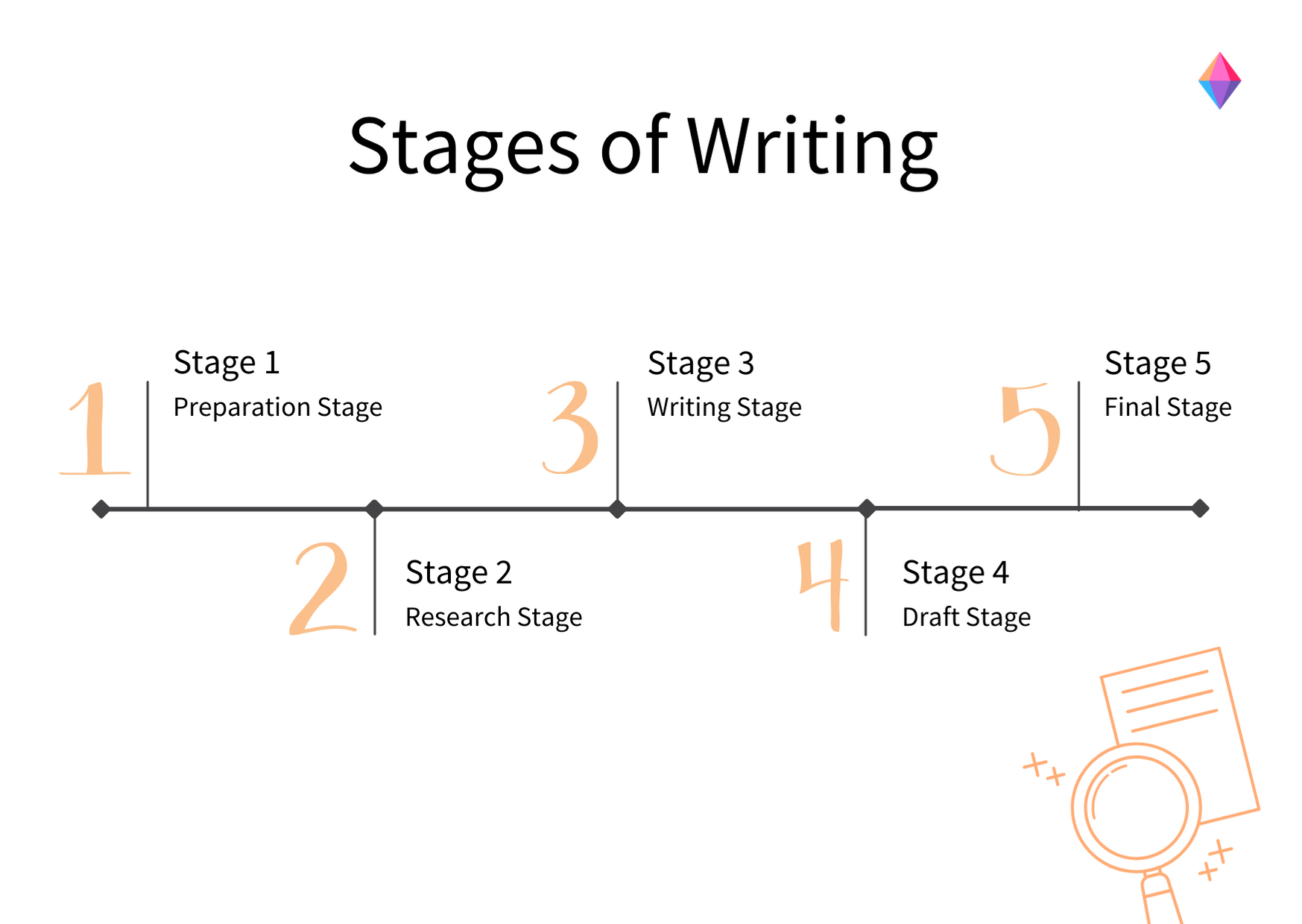
1. Preparation Stage
Before you start, it’s recommended to draft a plan or an outline of how you wish to begin preparing to write your research paper. Make note of the topic you will be writing on, as well as the stylistic and literary requirements for your paper.
2. Research Stage
In the research stage, finding good and useful literary material for background knowledge is vital. To find particular publications on a topic, you can use Google Scholar or access literary databases and institutions made available to you through your school, university, or institution.
Make sure to write down the source location of the literary material you find. Always include the reference title, author, page number, and source destination. This saves you time when formatting your paper in the later stages and helps keep the information you collect organized and referenceable.
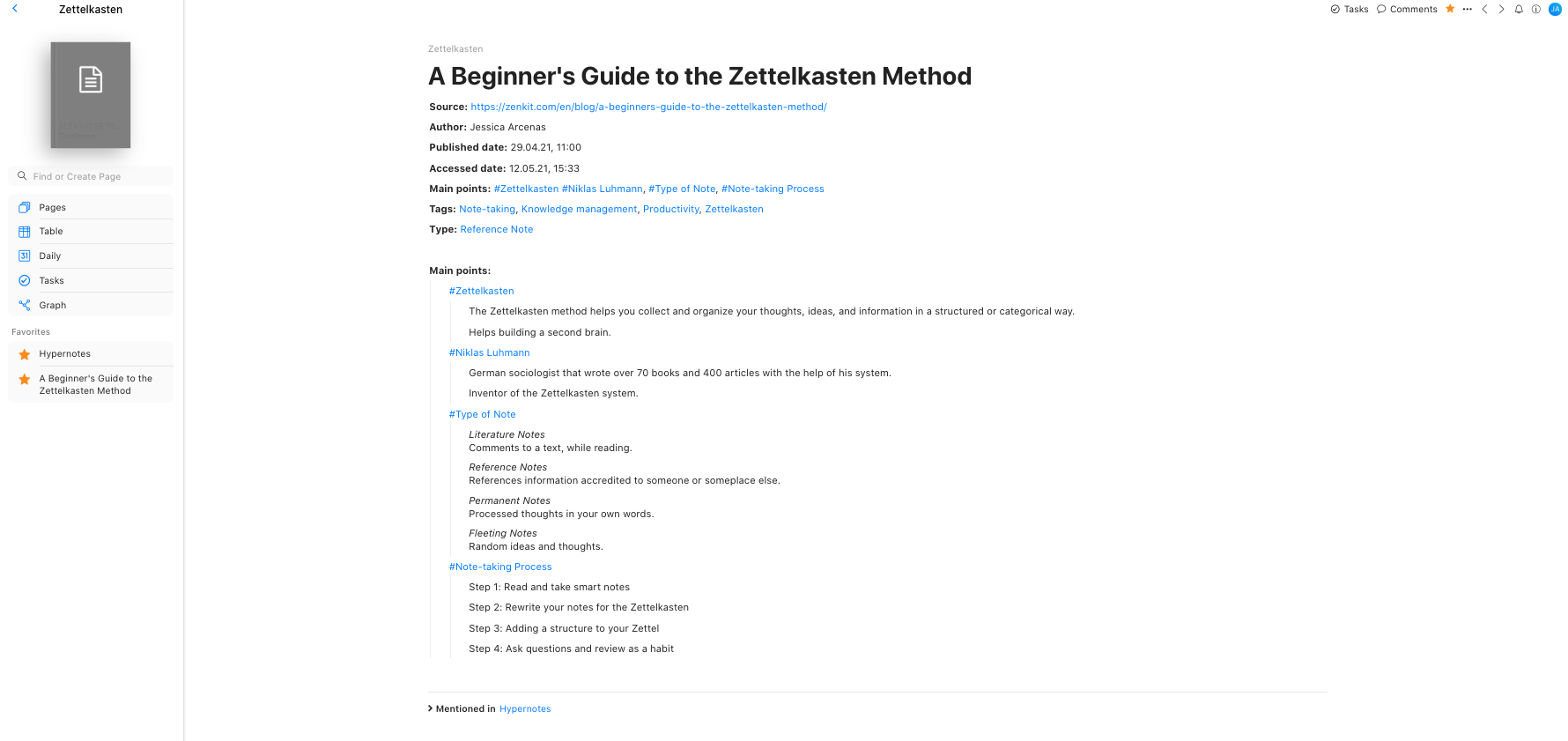
In the worst-case scenario, you’ll have to do a backward search to find the source of a quote you wrote down without reference to the original literary material.
3. Writing Stage
When writing, an outline or paper structure is helpful to visually break up the piece into sections. Once you have defined the sections, you can begin writing and referencing the information you have collected in the research stage.
Clearly mark which text pieces and information where you relied on background knowledge, which texts are directly sourced, and which information you summarized or have written in your own words. This is where your paper starts to take shape.
4. Draft Stage
After organizing all of your collected notes and starting to write your paper, you are already in the draft stage. In the draft stage, the background information collected and the text written in your own words come together. Every piece of information is structured by the subtopics and sections you defined in the previous stages.
5. Final Stage
Success! Well… almost! In the final stage, you look over your whole paper and check for consistency and any irrelevancies. Read through the entire paper for clarity, grammatical errors , and peace of mind that you have included everything important.
Make sure you use the correct formatting and referencing method requested by your University or institution for research papers. Don’t forget to save it and then send the paper on its way.
Best Practice Note-Taking Tips
- Find relevant and authoritative literary material through the search bar of literary databases and institutions.
- Practice citation repeatedly! Always keep a record of the reference book title, author, page number, and source location. At best, format the citation in the necessary format from the beginning.
- Organize your notes according to topic or reference to easily find the information again when in the writing stage. Work invested in the early stages eases the writing and editing process of the later stages.
- Summarize research notes and write in your own words as much as possible. Cite direct quotes and clearly mark copied text in your notes to avoid plagiarism.
Take Smart Notes
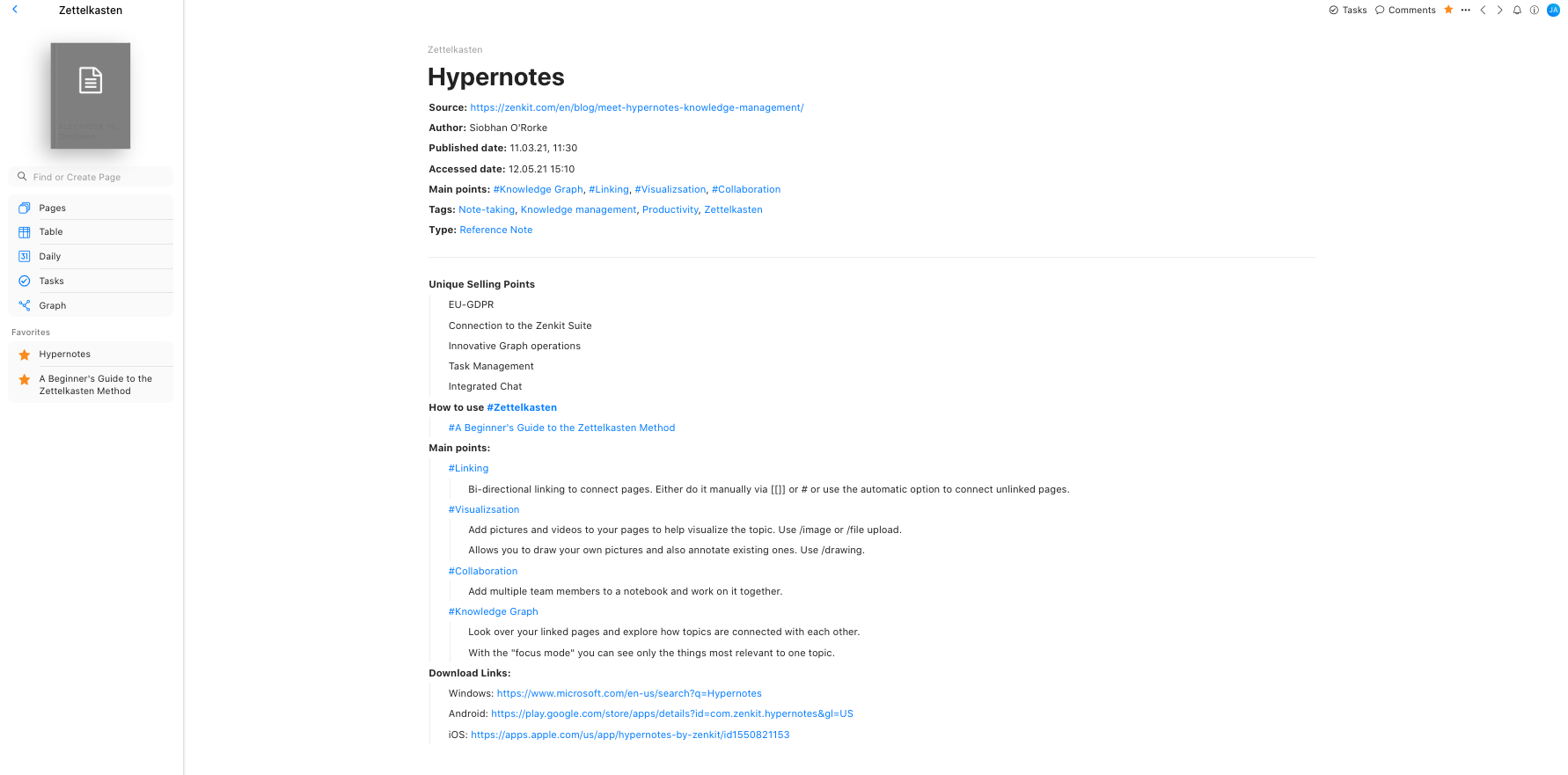
Taking smart notes isn’t as difficult as it seems. It’s simply a matter of principle, defined structure, and consistency. Whether you opt for a paper-based system or use a digital tool to write and organize your notes depends solely on your individual personality, needs, and workflow.
With various productivity apps promoting diverse techniques, a good note-taking system to take smart notes is the Zettelkasten Method . Invented by Niklas Luhmann, a german sociologist and researcher, the Zettelkasten Method is known as the smart note-taking method that popularized personalized knowledge management.
As a strategic process for thinking and writing, the Zettelkasten Method helps you organize your knowledge while working, studying, or researching. Directly translated as a ‘note box’, Zettelkasten is simply a framework to help organize your ideas, thoughts, and information by relating pieces of knowledge and connecting pieces of information to each other.
Hypernotes is a note-taking app that can be used as a software-based Zettelkasten, with integrated features to make smart note-taking so much easier, such as auto-connecting related notes, and syncing to multiple devices. In each notebook, you can create an archive of your thoughts, ideas, and information.
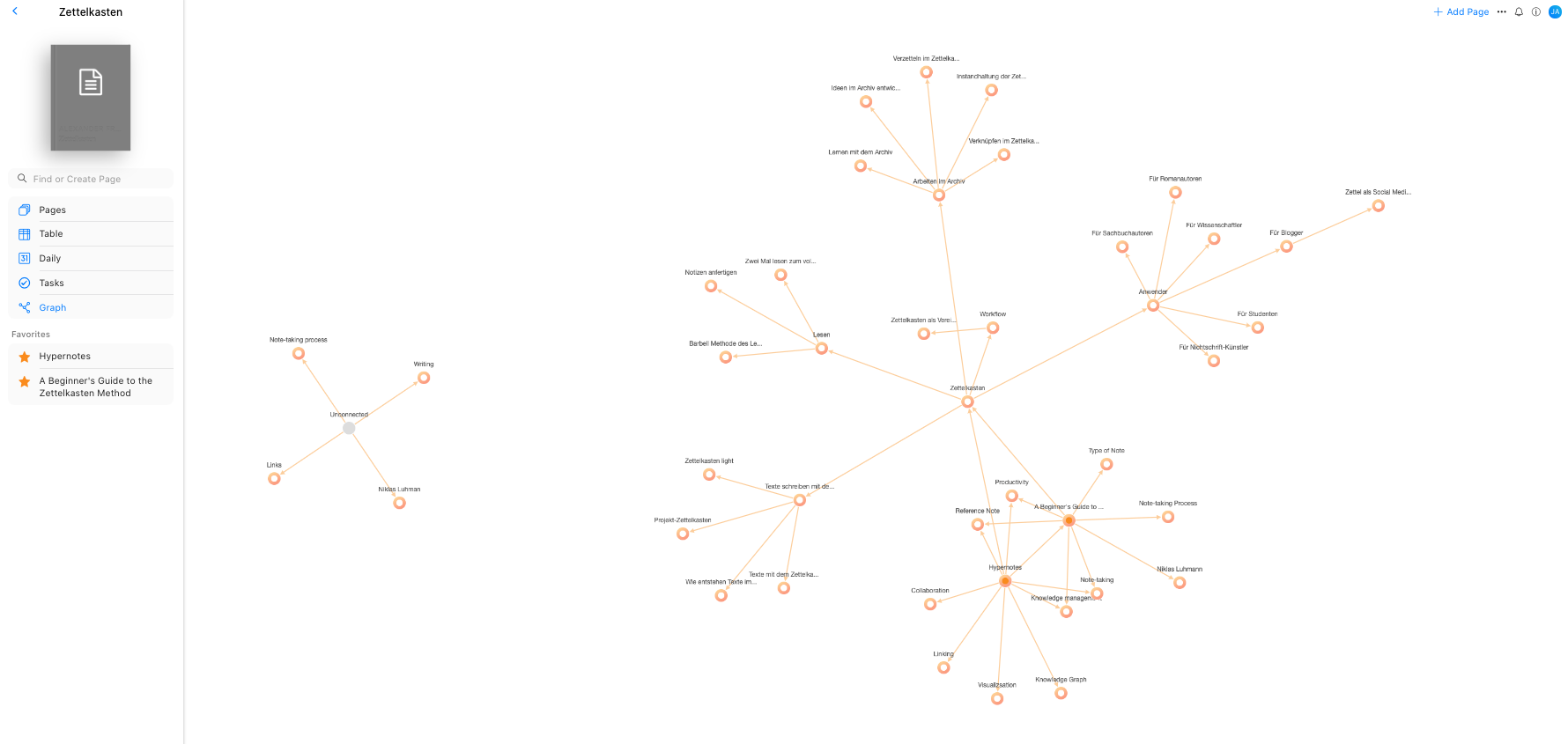
Using the tag system to connect like-minded ideas and information to one another and letting Hypernotes do its thing with bi-directional linking, you’ll soon create a web of knowledge about anything you’ve ever taken note of. This feature is extremely helpful to navigate through the enormous amounts of information you’ve written down. Another benefit is that it assists you in categorizing and making connections between your ideas, thoughts, and saved information in a single notebook. Navigate through your notes, ideas, and knowledge easily.
Ready, Set, Go!
Writing academic papers is no simple task. Depending on the requirements, resources available, and your personal research and writing style, techniques, apps, or practice help keep you organized and increase your productivity.
Whether you use a particular note-taking app like Hypernotes for your research paper writing or opt for a paper-based system, make sure you follow a particular structure. Repeat the steps that help you find the information you need quicker and allow you to reproduce or create knowledge naturally.
Images from NeONBRAND , hana_k and Surface via Unsplash
A well-written piece is made up of authoritative sources and uses the art of connecting ideas, thoughts, and information together. Good luck to all students and professionals working on research paper writing! We hope these tips help you in organizing the information and aid your workflow in your writing process.
Cheers, Jessica and the Zenkit Team

FREE 20 MIN. CONSULTATION WITH A PROJECT MANAGEMENT EXPERT
Wanna see how to simplify your workflow with Zenkit in less than a day?
- digital note app
- how to smart notes
- how to take notes
- hypernotes note app
- hypernotes take notes
- note archive software
- note taking app for students
- note taking tips
- note-taking
- note-taking app
- organize research paper
- reading notes
- research note taking
- research notes
- research paper writing
- smart notes
- taking notes zettelkasten method
- thesis writing
- writing a research paper
- writing a thesis paper
- zettelkasten method
More from Karen Bradford
10 Ways to Remember What You Study
More from Kelly Moser
How Hot Desking Elevates the Office Environment in 2024
More from Chris Harley
8 Productivity Tools for Successful Content Marketing
2 thoughts on “ Smart Note-Taking for Research Paper Writing ”
Thanks for sending really an exquisite text.
Great article thank you for sharing!
Leave a Reply Cancel reply
Your email address will not be published. Required fields are marked *
Save my name, email, and website in this browser for the next time I comment.
Zenkit Comment Policy
At Zenkit, we strive to post helpful, informative, and timely content. We want you to feel welcome to comment with your own thoughts, feedback, and critiques, however we do not welcome inappropriate or rude comments. We reserve the right to delete comments or ban users from commenting as needed to keep our comments section relevant and respectful.
What we encourage:
- Smart, informed, and helpful comments that contribute to the topic. Funny commentary is also thoroughly encouraged.
- Constructive criticism, either of the article itself or the ideas contained in it.
- Found technical issues with the site? Send an email to [email protected] and specify the issue and what kind of device, operating system, and OS version you are using.
- Noticed spam or inappropriate behaviour that we haven’t yet sorted out? Flag the comment or report the offending post to [email protected] .
What we’d rather you avoid:
Rude or inappropriate comments.
We welcome heated discourse, and we’re aware that some topics cover things people feel passionately about. We encourage you to voice your opinions, however in order for discussions to remain constructive, we ask that you remember to criticize ideas, not people.
Please avoid:
- name-calling
- ad hominem attacks
- responding to a post’s tone instead of its actual content
- knee-jerk contradiction
Comments that we find to be hateful, inflammatory, threatening, or harassing may be removed. This includes racist, gendered, ableist, ageist, homophobic, and transphobic slurs and language of any sort. If you don’t have something nice to say about another user, don't say it. Treat others the way you’d like to be treated.
Trolling or generally unkind behaviour
If you’re just here to wreak havoc and have some fun, and you’re not contributing meaningfully to the discussions, we will take actions to remove you from the conversation. Please also avoid flagging or downvoting other users’ comments just because you disagree with them.
Every interpretation of spamming is prohibited. This means no unauthorized promotion of your own brand, product, or blog, unauthorized advertisements, links to any kind of online gambling, malicious sites, or otherwise inappropriate material.
Comments that are irrelevant or that show you haven’t read the article
We know that some comments can veer into different topics at times, but remain related to the original topic. Be polite, and please avoid promoting off-topic commentary. Ditto avoid complaining we failed to mention certain topics when they were clearly covered in the piece. Make sure you read through the whole piece before saying your piece!
Breaches of privacy
This should really go without saying, but please do not post personal information that may be used by others for malicious purposes. Please also do not impersonate authors of this blog, or other commenters (that’s just weird).

IMAGES
VIDEO
COMMENTS
Now that we have covered the key components of a concept note, it is time to take you through a step-by-step guide to writing a winning concept note. Step 1: Research and Preparation Before you start writing your concept note, it is important to conduct thorough research on the problem you are seeking to address, the target audience, and the ...
Background. 300 words maximum. Three paragraphs maximum. Paragraph 1-. Provide the context of the study- why is a phenomenon of interest in relation to health service delivery or health outcomes in your region of interest. Provide recent background literature evidence on the research phenomenon.
Additionally, infographics and scientific illustrations can enhance the document's impact and engagement with the audience. The steps to write a concept paper are as follows: 1. Write a Crisp Title: Choose a clear, descriptive title that encapsulates the main idea. The title should express the paper's content.
to interest potential funders. to develop potential solutions or investigations into project ideas. to determine whether a project idea is fundable. to serve as the foundation of a full proposal. Funders that request concept papers often provide a template or format. If templates or formats are not provided, the following can serve as a useful ...
Therefore, in order to write a simple concept paper, follow these steps: 1. Concept paper title. Every pa per must have a title and concept paper is not left out as one needs to have a title that ...
1. To explore and expand an idea: Researchers can use concept papers to transform an incipient research idea into a focused, high-quality study proposal. The paper is also a means to obtain feedback that can be used to strengthen a detailed proposal at a later stage. 2. To draw the interest of funding agencies: Through an effective concept ...
A five-to-ten-page concept note is sufficient in most cases. The concept note is prepared as part of the application to provisional admission and needs to be uploaded as part of the application material on SUNStudent. Candidates that are provisionally admitted, will work with their academic supervisors to prepare a full doctoral proposal that ...
A concept paper is a short document written by a researcher before starting their research project, with the purpose of explaining what the study is about, why it is important and the methods that will be used. The concept paper will include your proposed research title, a brief introduction to the subject, the aim of the study, the research ...
Learn how to write a concept paper for your research proposal with clear examples and tips in this video. Watch now and get your proposal approved.
Stephen D. Reese. The conceptual article can make a valuable contribution to the scholarly conversation but presents its own special challenges compared to the traditional article that reports empirical findings or interpretive analysis with a familiar organizational structure. This article provides a guide to this task, organized around the ...
A concept paper might be the first thing a funding round requests to get an idea of what the project is all about. So make sure that it includes: Importance of the work being proposed. What the impact (not the same as ' impact factor ' - see later below) will be. How the outcomes of your project might meet or respond to the need.
A concept paper is often used to generate feedback and guidance from a program officer before a full grant proposal is developed. In most cases, the program officer will be, or will have been, a researcher, clinician, or scholar, like yourself. Before you start writing, think about the Golden Rule and the kind of project summary you'd like to ...
Concept Paper vs. Research Proposal. Getting Started on Your Concept Paper. 1. Find a research topic you are interested in. Tips for finding your research topic. 2. Think of research questions that you want to answer in your project. 3. Formulate your research hypothesis.
The title of the proposed study is the first element of a concept paper. The title should describe what the study is about by highlighting the variables of the study and the relationship between the variables if applicable. The title should be short and specific: it is best to have a title that is not more than 15 words' long.
The purpose of a concept paperfrom the funder's point of view is to determine if the proposed project aligns with their mission and strategic goals, is competitive and fundable, and is likely to yield results that will advance the field. The researcher's purpose in developing a concept paper is to capture the interest of the funder ...
Structure of the Concept Note/paper As a guide a nd to encourage uniformity in assessment of the concept papers, all applicants should structure their concept papers; taking into account the preceding
Funders that request concept papers often provide a template or format. If templates or formats are not provided, the following can serve as a useful concept paper structure. THE FIVE ELEMENTS OF A CONCEPT PAPER 1. The first section, the Introduction, identifies how and where the applicant's mission and the funder's mission intersect or align.
A concept paper for a Ph.D. is a written statement outlining the objectives and concepts of a proposed research study. It acts as an introduction to your dissertation or full thesis. It is also an important part of the application process for Ph.D. programs and helps the admissions committee evaluate a student's research potential.
Otherwise, type your paper in a standard font at a readable size (12 point is good), number your pages, and use reasonable margins (1 inch all around is fine). 2. Check that the language of your concept paper is action-oriented. Sponsors are looking for projects that are well-thought out and doable.
In order to write a concept note, the following steps would be useful: Start the concept note with a title. The header section would include information like submitted by along with the date of submission. It is important to keep in mind that the title should be short; however, it would be such that it reflects information about the project.
Determine whether your research is aligned with their own interests and experience. Whether there is capacity in the research group to accommodate your study Writing a concept note will assist you in clarifying your ideas, defining your research topic and presenting the material in a logical and coherent manner.
Postgraduate Concept Paper Template A concept paper is meant to give your Department an idea of your area of research interest in order to avail the necessary assistance for you to develop a research proposal. Be as specific as possible in providing information. The Structure of a Concept Note; 1. Title of Proposed Study: 2. Area of Study: 3.
The Purdue On-Campus Writing Lab and Purdue Online Writing Lab assist clients in their development as writers—no matter what their skill level—with on-campus consultations, online participation, and community engagement. The Purdue Writing Lab serves the Purdue, West Lafayette, campus and coordinates with local literacy initiatives.
Note-taking for research papers requires focus and careful deliberation of which information is important to note down, keep on file, or use and reference in your own writing. Depending on the topic and requirements of your research paper from your University or institution, your notes might include explanations of complex theories, definitions ...